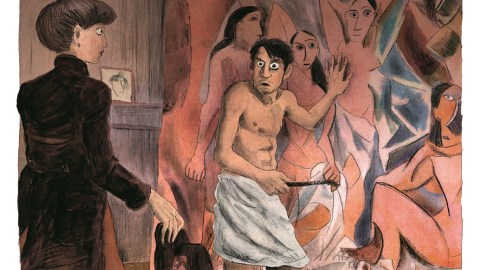Why the Best Film about Pablo Picasso Is a Graphic Novel

Artists aren’t easy people to be around sometimes. Genius and jerk often walk hand in hand. They may suffer for their art, but those who support them often become collateral damage in the quest for immortality. Making a biopic of any artist and balancing the good with the bad seems an almost impossible task. Making a biopic of Pablo Picasso, a classic case study of the genius-as-jerk, that praises the painting while honestly assessing the collateral damage to women has never satisfactorily been filmed. But where cinema fails, maybe the cinematic graphic novel can succeed. The graphic novel Pablo, written by Julie Birmant and illustrated by Clément Oubrerie, is the best “film” ever made about one of the founding fathers of modern art — a portrait of intertwined genius and jerk that never loses sight of either side.
Even Anthony Hopkins (as Picasso) and the Merchant Ivory team couldn’t survive the muddled mess of Surviving Picasso, the 1996 film following Picasso in the 1940s as he endures the Nazi occupation of Paris and tests the endurance of a succession of women, including Olga Khokhlova, Dora Maar, Marie-Thérèse Walter, and Jacqueline Roque. It didn’t help that producers failed to obtain permission to show Picasso’s art on film, which made the art visually as well as spiritual absent as the story focused on Picasso’s personal life. Surviving Picasso is all jerk and little genius, unless you can count a talent for chronic emotional abuse and serial unfaithfulness to women a kind of genius. More recently, Timothy Spall’s portrayal of J. M. W. Turner in Mike Leigh’s 2014 biopic Mr. Turner also featured Turner’s flawed relationships with females overwhelmingly over his art (although many critics and awards felt differently). I love Turner’s work, but continually felt frustrated with how the film kept telling us about his greatness without ever getting into the art in any depth. Turner’s art in Mr. Turner felt more like a narrative device to justify his jerkiness than the real reason for making and watching his story.
Taking on this challenge, Birmant and Oubrerie reach back to the beginning of Picasso’s career. Like Surviving Picasso, Pablo tells its story through the eyes of the women in Picasso’s life. Unlike Surviving Picasso, Pablo speaks through the one woman who knew and loved and suffered by Picasso before he became famous — Fernande Olivier. Thanks to Fernande’s memoirs (some published in the 1930s, until Picasso paid for her silence to the end of her life in 1966, with the rest published in 1988), Birmant can recreate the strong voice of this young woman who broke free of her restrictive life and found a home among the bohemians of Montmartre. “To be young in Montmartre in 1900 was to know cruelty, violence, madness,” Fernande reminisces in Pablo. “In this filth, this slum where a band of ragged immigrants in rags invented modern art Picasso loved me. Picasso painted me. He always wanted to erase me from sight. Instead, he made me eternal.” Pablo corrects the erasure of so many other Picasso biographies by refusing to allow the artist to overshadow his subject-lover and, thus, allows the art itself to speak more clearly and fully. The art is both genius and jerk. Cover either side and you can’t see it completely.
Pablo brings turn of the century Montmartre to life in all its ragged, filthy, daring glory. “You screw like you paint,” a lover spits back at Picasso as she storms out of his life, “all surface, no depth.” Nothing is sacred here, even Picasso and “all surface” Cubism. The comedy continues as the Spanish-speaking Picasso struggles to learn French while developing his new style. Into his life comes the strong-willed Fernande, whose beauty instantly enthralls Picasso. Fernande resists Picasso the man until she sees the work of Picasso the artist. No mere model to be painted and discarded like others, Fernande occupies a place in Picasso’s life, work, and legacy. Looking for the first time at Les Demoiselles d’Avignon (shown above), Fernande instantly recognizes the complexity of their relationship playing out in Picasso’s art. “The woman in the middle was me, slain and indifferent,” she realizes, “but all the other women were me, too — deformed and monstrous.” Their physical relationship ends there, but their spiritual and artistic life together never ends.
Pablo remarkably demonstrates how his loves, his childhood, and his lost friends all haunt Picasso, who hopes to exorcise those demons in his art. In that way, Pablo gets into and behind the art “cinematically” in a way that no film has yet. Oubrerie’s dynamic line and energetic visual compositions really make you feel like you’re watching a movie, but the medium of graphic novel transcends the limitations of film in which you’re watching real people “act” like Picasso, etc. Oubrerie recasts Les Demoiselles d’Avignon with the faces and bodies of his critics, who can’t “get” his new art, that injects humor into the story while also employing the art imaginatively to tell it. Such magic realism, which can come off as phony on film, works well in novels, especially graphic novels.
For art aficionados, Pablo doesn’t disappoint with the cameos. Edgar Degas pokes his head in, “half-blind, but as anti-Semitic as ever.” Henri Matisse emerges as the great rival (with the rivalry overplayed a bit). Gertrude Stein, a “plump Buddha,” makes her presence known. The famous party for “Le Douanier,” Henri Rousseau, brings back all the camaraderie among the competition. Perhaps the best and most interesting supporting character is the unjustly forgotten Max Jacob, an early supporter of Picasso as well as an artist in his own right. Pablo tells the story of Picasso, of course, but it also manages to tell the story of the people, such as Jacob and Fernande Olivier, who helped make Pablo into “Picasso.”
“To anarchy! To women!” the artists toast at an impromptu party in Pablo full of the former, but sorely lacking the latter. Birmant and Oubrerie’s Pablo lacks neither while allowing both to shine. Fernande Olivier emerges as an equal partner while refusing to become passive collateral damage. That feminist touch solves the quandary of Picasso’s misogyny while allowing you to see how his art is often equal parts anarchy and women. For those who’ve longed for the great film about Picasso, stop looking at the Cineplex and start looking for Pablo in your bookstore.
[Image:Fernande Olivier confronts Pablo Picasso painting Les Demoiselles d’Avignon in Pablo.]
[Many thanks to SelfMadeHero and Abrams Books for providing me with the image above from and a review copy of Pablo, written by Julie Birmant and illustrated by Clément Oubrerie (translated from the French by Edward Gauvin).]
[Please follow me on Twitter (@BobDPictureThis) and Facebook (Art Blog By Bob) for more art news and views.]




